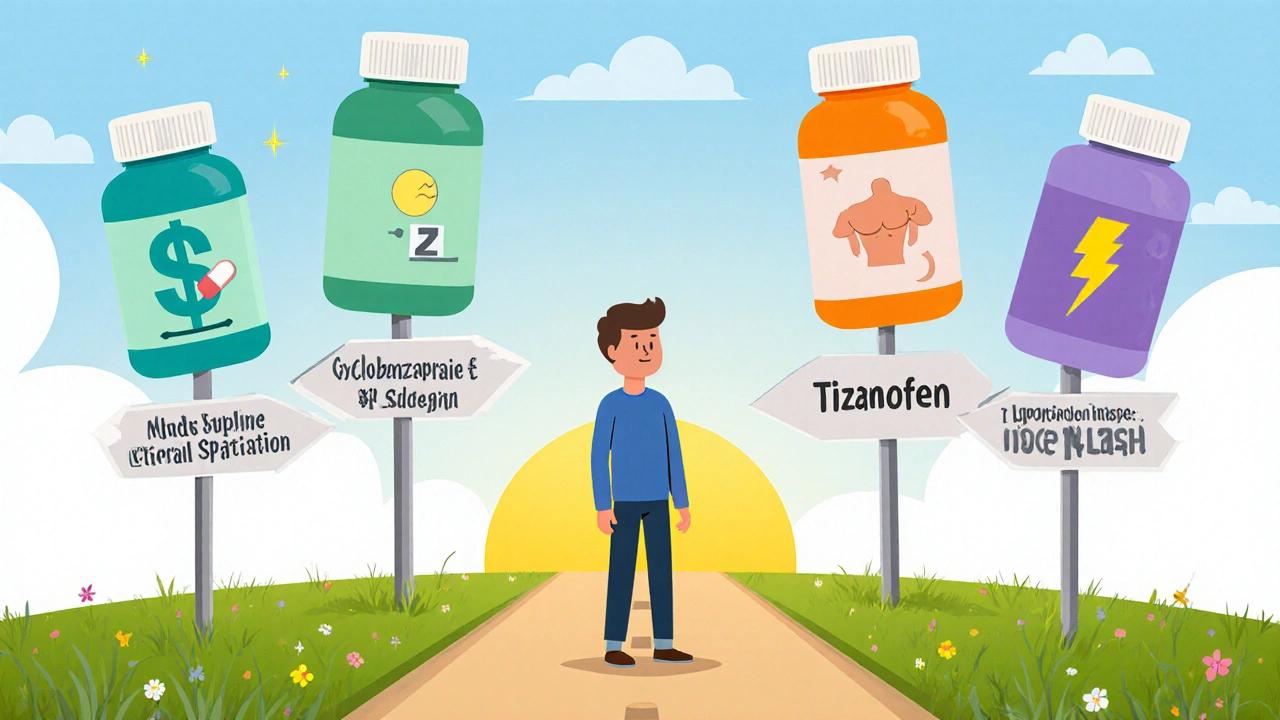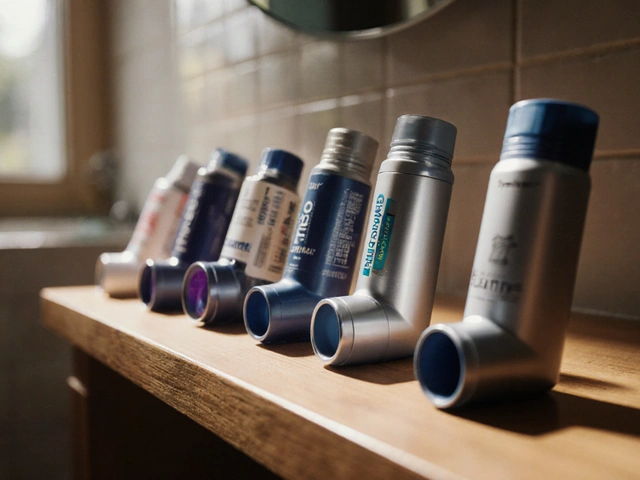Looking for a clear picture of how Robaxin stacks up against other muscle relaxants? You’re not alone. Many people need to know which option eases muscle spasms best, has the fewest side effects, and fits their budget. This guide walks you through the science, the practicalities, and the real‑world pros and cons of Robaxin and its most common rivals.
What is Robaxin (Methocarbamol)?
Robaxin (Methocarbamol) is a centrally acting muscle relaxant that’s been prescribed for decades to treat acute musculoskeletal pain and muscle spasms. It’s typically taken orally in 500mg or 750mg tablets, three to four times a day, depending on the severity of the spasm. Though the exact mechanism isn’t fully understood, the drug appears to dampen nervous system activity that leads to involuntary muscle contractions.
How does Robaxin work?
Methocarbamol’s primary action is thought to be inhibition of the central nervous system’s reflex pathways. By reducing the hyper‑excitability of motor neurons, it helps break the cycle of pain‑spasm‑pain. This makes it useful for conditions like back strain, neck pain, and post‑operative muscle stiffness.
Key attributes to compare when choosing a muscle relaxant
Before we dive into alternatives, let’s flag the factors that matter most:
- Mechanism of action: How the drug relaxes muscles.
- Onset of relief: How quickly you feel better.
- Duration: How long the effect lasts per dose.
- Common side effects: Sedation, dizziness, GI upset, etc.
- Contraindications: Who should avoid it.
- Cost and insurance coverage: Real‑world affordability.

Alternative muscle relaxants
Below are the five most frequently prescribed alternatives, each with its own strengths.
Cyclobenzaprine works by blocking nerve impulses that cause muscle tightness. It’s often sold under the brand name Flexeril and is taken once daily (10mg) for short‑term use (up to three weeks). Its sedative effect can be strong, which some patients find helpful for nighttime pain but troublesome during the day.
Baclofen is a GABA‑B receptor agonist that reduces spasticity by relaxing skeletal muscle. It’s popular for chronic conditions like multiple sclerosis. Typical dosing starts at 5mg three times daily, titrating up to 80mg per day.
Tizanidine is an alpha‑2 adrenergic agonist that lowers muscle tone. It’s short‑acting, making it useful for intermittent spasms. Starting dose is 2mg before bedtime, with possible increases to 8mg three times a day.
Metaxalone is a less potent relaxant that blocks nerve signals in the spinal cord. Because it causes fewer drowsy side effects, it’s often chosen for patients who need to stay alert. Dosage is usually 800mg three times daily.
Carisoprodol (Soma) acts centrally to depress the nervous system and alleviate muscle pain. It’s taken three times daily (250mg) but is classified as a controlled substance in many regions due to potential for dependence.
Side‑effect profile comparison
All muscle relaxants can cause drowsiness, but the intensity varies:
- Robaxin: Generally mild sedation, dry mouth, and occasional GI upset.
- Cyclobenzaprine: Strong sedation, anticholinergic effects (dry mouth, blurry vision), risk of tachycardia.
- Baclofen: Can cause weakness, fatigue, and in rare cases, seizures if stopped abruptly.
- Tizanidine: Notable dizziness, dry mouth, and potential liver enzyme elevation.
- Metaxalone: Light sedation, upset stomach; considered the gentlest.
- Carisoprodol: Prominent drowsiness, risk of dependence, withdrawal symptoms.
Choosing the right drug often hinges on how much sedation you can tolerate.

Cost and accessibility
Price can swing dramatically based on generic availability and insurance formularies. As of 2025:
- Robaxin (generic methocarbamol): Approx. $0.15 per 500mg tablet in Canada, covered by most provincial drug plans.
- Cyclobenzaprine: Around $0.30 per 10mg tablet; generic versions are common.
- Baclofen: $0.10 per 10mg tablet, widely available as a generic.
- Tizanidine: $0.25 per 2mg tablet; some insurers require prior authorization.
- Metaxalone: $0.20 per 800mg tablet, generic only.
- Carisoprodol: $0.40 per 250mg tablet; limited coverage due to scheduling.
Overall, methocarbamol remains one of the most budget‑friendly options.
Quick comparison table
| Drug | Mechanism | Typical Onset | Main Side Effects | Typical Daily Dose | Average Cost (CAD) |
|---|---|---|---|---|---|
| Robaxin (Methocarbamol) | Central nervous system depressant (exact mechanism unknown) | 30‑60min | Mild drowsiness, dry mouth | 500‑750mg 3‑4×/day | ~$0.15/tablet |
| Cyclobenzaprine | Tricyclic antidepressant‑like, blocks NMDA receptors | 1‑2h | Strong sedation, anticholinergic | 10mg once daily | ~$0.30/tablet |
| Baclofen | GABA‑B agonist | 45‑60min | Weakness, fatigue | 5‑20mg 3×/day | ~$0.10/tablet |
| Tizanidine | Alpha‑2 adrenergic agonist | 15‑30min | Dizziness, liver enzyme rise | 2‑8mg 3×/day | ~$0.25/tablet |
| Metaxalone | Spinal cord nerve signal blocker | 45‑60min | Light sedation, upset stomach | 800mg 3×/day | ~$0.20/tablet |
| Carisoprodol | Central depressant, metabolized to meprobamate | 30‑60min | Strong drowsiness, dependence risk | 250mg 3×/day | ~$0.40/tablet |
When to choose which muscle relaxant
If you need short‑term relief after a minor injury and want a low‑cost, low‑sedation option, Robaxin is a solid pick. Its mild side‑effect profile makes it suitable for people who still need to drive or operate machinery.
For patients who struggle with nighttime spasms and can tolerate a stronger calming effect, Cyclobenzaprine may be preferable. Its once‑daily dosing simplifies schedules but beware of anticholinergic symptoms.
Those with chronic spasticity from neurological disorders often benefit from Baclofen or Tizanidine, as both have proven efficacy in long‑term management. Baclofen’s oral form is cheap, while Tizanidine’s rapid onset can be useful for breakthrough spasms.
If you’re sensitive to drowsiness and need a gentler agent, Metaxalone offers a lighter sedation profile, though its muscle‑relaxing potency is modest.
Finally, Carisoprodol should be reserved for patients who have exhausted other options and are under careful monitoring due to its abuse potential.
Bottom line
All muscle relaxants share the goal of easing painful muscle contractions, but they differ in how fast they work, how long they keep you relaxed, and how likely they are to make you sleepy. By matching the drug’s profile to your lifestyle, health status, and budget, you can pick the one that fits you best. Whether you stay with Robaxin or switch to an alternative, always discuss dosing and potential interactions with your healthcare provider.
Frequently Asked Questions
How quickly does Robaxin start working?
Most patients notice reduced muscle tightness within 30 to 60 minutes after taking a dose.
Can I take Robaxin with alcohol?
It’s best to avoid alcohol because both can increase drowsiness and impair coordination.
Is Robaxin safe for pregnant women?
Robaxin falls under FDA pregnancy category C; only use it if the benefits outweigh potential risks and under doctor supervision.
What are the main differences between Robaxin and Cyclobenzaprine?
Robaxin is less sedating and cheaper, while Cyclobenzaprine often causes stronger drowsiness but can be taken once daily.
Can I switch from Baclofen to Robaxin?
A gradual taper of Baclofen is recommended to avoid withdrawal; discuss the switch with your physician.








Carissa Padilha October 17, 2025
Ever wonder why the pharma giants keep pushing cheap muscle relaxants like Robaxin while hiding the real truth?
They claim it's all about cost and safety, but the data they release is cherry‑picked to protect their bottom line.
The studies that show Robaxin’s mild sedation are funded by the same companies that own the distribution channels.
Meanwhile, the more effective alternatives get buried under endless paperwork and arbitrary “prior authorization” hurdles.
What if the real reason they love methocarbamol is that it’s easy to manufacture and leaves them room to squeeze profit margins without raising red flags?
Consider the pattern: every time a new competitor like Tizanidine appears, the insurers suddenly claim it’s “experimental” and refuse coverage.
This isn’t coincidence; it’s a coordinated effort to keep the market locked on a handful of generic pills they can control.
Think about the “sedation” claim – it’s vague, and they never disclose the exact scales used in trials.
Patients are left in the dark, believing they’re choosing the safest option when in reality they might be missing a drug that works faster with fewer side effects.
And let’s not forget the hidden fees that get tacked onto a simple prescription for Robaxin, inflating the price for the average consumer.
All the while, the headlines push “budget‑friendly” narratives that distract from the underlying manipulation.
If you dig deeper, you’ll see a web of lobbying, ghostwritten articles, and a revolving door between regulators and drug manufacturers.
So next time you see a cheap price tag, ask yourself: who’s really benefiting from this “deal”?
Stay skeptical, because the truth about muscle relaxants is often more complicated than the glossy brochures let on.
Richard O'Callaghan October 18, 2025
Hey, i cant bElieve how many ppl just take robaxin without even readin the label. you gotta check the side effects like dizzines and dry mouth, they r real. also, dont mix it w/ alchohol - that combo can make you pass out at evertime. i know it sounds like i’m naggin but trust me, i’ve seen folks end up in the ER cuz they ignored the warnings. se my point?
Joanna Mensch October 19, 2025
Robaxin sounds cheap but it’s not always the best choice.
RJ Samuel October 21, 2025
Honestly, the whole “Robaxin is the budget hero” narrative is a bit of a fairy‑tale, mate. While it’s true the tablets are easy on the wallet, you’re trading off a punchier effect you’d get from something like Cyclobenzaprine. If you’re after a quick “knock‑out” for those nasty night‑time spasms, a stronger sedative might actually be a blessing. And let’s not pretend the mild sedation isn’t a marketing spin – it’s just another way to keep you from noticing the real potency differences. In my view, the best muscle relaxant is the one that aligns with your schedule, not the one that fits a generic price tag.
Nickolas Mark Ewald October 22, 2025
Robaxin does a decent job for short‑term muscle pain and it’s easy on the budget, which makes it a solid option for many people who need quick relief without heavy sedation.
Chris Beck October 23, 2025
Look, Nickolas, you’re missing the bigger picture – these cheap drugs keep our healthcare system afloat! If we keep buying the low‑cost options, we’re supporting the national pharma industry that fuels our economy. Sure, the side‑effects are mild, but why settle for “decent” when there’s a stronger, more “British” solution out there? Your simple “budget” line ignores the strategic advantage of sourcing higher‑potency meds from homegrown labs. Don't be fooled.
Sara Werb October 24, 2025
Wow!! This whole comparison feels like a Hollywood script where the underdog Robaxin is forced to play second fiddle to the flashy, over‑the‑top Cyclobenzaprine!! The drama of sedation levels, the clash of costs – it’s practically a soap opera!! And don’t even get me started on the way insurers push us toward the “cheapest” option like it’s some patriotic duty!! It’s crazy!!
Russell Abelido October 25, 2025
I hear the frustration in your words, Sara, and it’s understandable why these choices can feel like a high‑stakes drama. The balance between effectiveness and affordability often leaves patients caught in a tug‑of‑war between their bodies and the system. It’s a tough spot, but remembering that a calm mind can sometimes ease muscle tension is worth considering. 😊
Emily Rankin October 26, 2025
Indeed, the paradox of seeking tranquility through chemical means mirrors the age‑old philosophical dilemma of external versus internal control. While a muscle relaxant may quiet the flesh, the mind remains a battlefield where true peace must be cultivated. Thus, even the most potent drug cannot replace the inner work required to harmonize body and spirit.
Steve Holmes October 27, 2025
Interesting breakdown! I’m curious about the liver enzyme concerns with Tizanidine – does anyone have real‑world data on how often that becomes a clinical issue? Also, how does the onset time compare when patients are on multiple meds?
Tom Green October 29, 2025
Great questions, Steve. In practice, clinicians monitor liver enzymes in patients on Tizanidine, especially if they have pre‑existing hepatic conditions; significant elevations are relatively uncommon but not unheard of. As for onset, Tizanidine typically acts within 15‑30 minutes, which can be faster than Baclofen or Methocarbamol, though individual responses vary, particularly when other medications that affect metabolism are involved.
Rebecca Mitchell October 30, 2025
Robaxin works okay for me I take it after workouts and it doesn’t make me drowsy
Roberta Makaravage October 31, 2025
🚨 Fact check: Robaxin’s mechanism is still not fully elucidated, contrary to many oversimplified articles that claim it “just works.” The drug modulates polysynaptic pathways in the spinal cord, and the evidence points to a complex interaction with GABAergic transmission. 📚 Moreover, the notion that it’s universally the cheapest option ignores regional pricing discrepancies and insurance formularies. 📈 So before you label it the ultimate budget hero, consider the nuanced pharmacodynamics and the economic landscape.
Lauren Sproule November 1, 2025
I appreciate all these perspectives – it really helps to see both the clinical details and the personal experiences. It’s clear there’s no one‑size‑fits‑all answer, and discussing options openly can empower everyone to make better choices.
CHIRAG AGARWAL November 2, 2025
Honestly, these muscle relaxant guides are just a bunch of boring textbook stuff. Who cares about tables and costs? Just pick whatever your doctor says and move on.